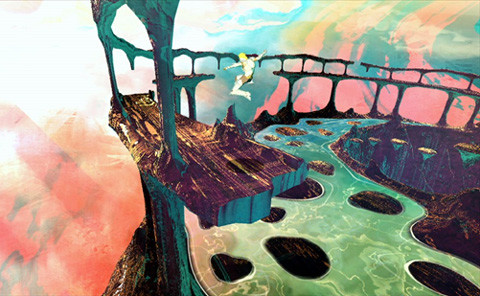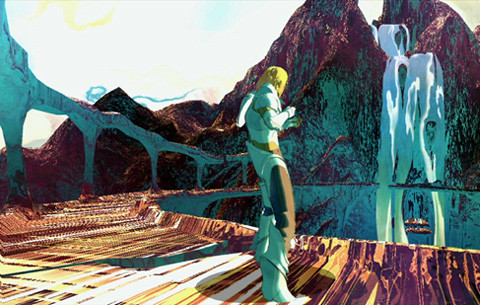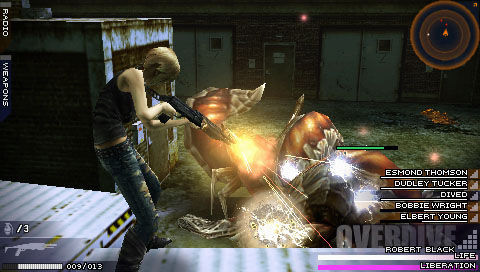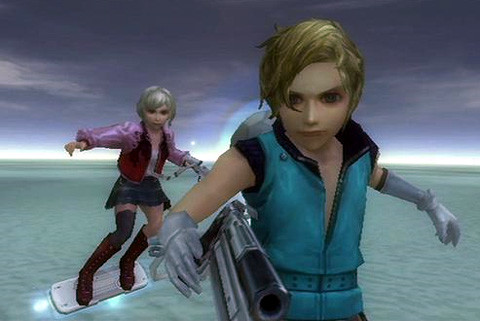- remind me tomorrow
- remind me next week
- never remind me
The X Button
Secrets of Successors
by Todd Ciolek,

I'm reviewing a Treasure game this week, and it brings me back to a time in my life when I seriously collected games. I sold off most of those games some time ago, but there was a point where I wanted as many as I could afford, and I especially wanted to own every game made by Treasure.
It was a calculated decision. Unlike Square Enix or Konami, Treasure is a small developer with a modest library of games, so I could fit their entire collection into one bookcase. Unlike Compile or Right Stuff, Treasure makes games primarily for consoles, so I wouldn't have to track down all sorts of old Japanese computer software. It was a perfectly reasonable goal, or so I thought for about nine minutes.

Then I realized that many Treasure games are stupidly expensive, particularly when they come out only in Japan. Rakugaki Showtime, Alien Soldier, and Radiant Silvergun all ran well over $100 on eBay and in Japanese second-hand stores. Even though I'd picked up Radiant, Guardian Heroes, and some other rarities when they were new and relatively cheap, owning the entire Treasure catalog would've cost me about a thousand dollars.
And there was another matter. Like any developer, Treasure makes bad games as well as good ones, and I couldn't come up with any reasons to own mediocrities like Light Crusader and Silpheed: The Lost Planet. It made me realize how foolish it was to collect games I didn't care about, and it was the beginning of the end for my game-buying mania. I'm glad I stopped before I talked myself into picking up Dragon Drive, Tiny Toon Adventures: Scary Dreams, and other lousy Treasure offerings.
Fortunately, Sin and Punishment: Star Successor is the opposite of a lousy Treasure offering, and you should all go buy it. You probably don't have to worry about it becoming supremely rare and pricey, as it was released by Nintendo and advertised on TV. But you never know.
NEWS
NEW BLAZBLUE CHARACTERS SLIP OUT
BlazBlue: Continuum Shift might have a good idea with its downloadable characters. Sure, it expects players to pay for extra fighters in a game they've already purchased, but those players are also free to ignore any download-only characters they don't much like. That means that you won't have to pay for a squirrel-woman, a supernatural butler, or a multiple-personality magical girl if you don't want to. Makoto, the aforementioned woodland creature, was unveiled just last month, and the two other characters were recently sniffed out by overeager fans.

The butler in question is Valkenhayn Hellsing, an elderly servant of vampire princess Rachel Alucard. In BlazBlue canon, he's one of six legendary heroes from the Dark War, and his background should prove interesting to those who follow BlazBlue: Continuum Shift's story mode. He's also a notable change for a fighting series that frequently fattens its rosters with young women. Speaking of which…

That's Platina the Trinity, and unless someone's pulling off a massive hoax, she's an actual character in BlazBlue: Continuum Shift. A staff-wielding, heart-irised example of the modern magical girl, Platina has three separate personalities: a meek young woman named Lena, a rude male psyche named Sena, and the often-hidden spirit of Platinum, one of the six heroes. Looking like she wandered out of Arcana Heart or the moe-anime parody game from No More Heroes 2, Platina is easily BlazBlue's most obvious anime stereotype yet, and she might alienate some players. I'd count myself among those players, though perhaps I'm just resentful at seeing the name “Platina” in a game that's not Valkyrie Profile.
Platina and Valkenhayn should be available for download around the same time as Makoto, and for roughly the same price in Japan: 560 Xbox Live Points or 800 yen on the PlayStation Network. That's roughly eight dollars per character, though Aksys hasn't yet announced North American price tags. Nor has Aksys nailed down the pricing for the rest of the game's downloadable content, which includes an instantly unlocked mu-12 (200 yen in Japan), Unlimited versions of the other characters (60 yen each), voice packs (600 yen each), and extra color-change options (500 yen each). The standard-issue BlazBlue: Continuum Shift is still coming here on July 27, by the way.
EL SHADDAI IS THE NEW FACE OF BIBLE ADVENTURES
Video games are no strangers to overt Biblical symbolism, especially not when those games are made by Japanese developers who strip-mine Judeo-Christian lore with crazed abandon. Ignition's El Shaddai: Ascension of the Metatron, however, might be the most bizarre appropriation of religious references this side of Xenosaga and those Wisdom Tree NES games. Developed by former members of Capcom's Clover squad, El Shaddai is a visually striking action title based on the Book of Enoch, a particularly insane ancient text that was kicked out of most branches of Christianity and Judaism.

Enoch's best known for its tales of fallen angels siring children with humans, and that's where El Shaddai appropriates its backstory. The game's hero, Enoch, is a human caught up in a war among angels, as he's tracking down the fallen ones before the Heavens just get sick of the whole mess and destroy the planet. When not using his bladed arch weapon to carve through rogue angels and their servants, Enoch gets advice from a time-traveling Lucifel (yes, that's how Ignition is apparently spelling it) who's picked up his fashions from the 20th century.

Beyond the deliberately arcane story, El Shaddai looks vivid, combining the stark cel-shading of Killer 7 with huge levels that have a weird, pared-down sense of antediluvian grandeur. The gameplay sticks to the brawler mechanics of God of War or Devil May Cry, though Enoch's capable of wielding all sorts of weapons and breaking enemies' armor. El Shaddai, with its rampant and likely unfaithful religious imagery, is still under wraps at Ignition's Japanese studio, and it's headed for the PlayStation 3 and Xbox 360 next year.
THE 3RD BIRTHDAY'S LOOKING GOOD
Square Enix didn't release many new details this week regarding The 3rd Birthday, the PSP-based Parasite Eve 3 in everything but name, but they released a bunch of pretty new screenshots.

Many show off the game's battle system, which seems a lot more dynamic than the original's RPG gameplay or the second Parasite Eve's straight Resident Evil mechanics. The 3rd Birthday has plenty of real-life firearms for heroine Aya Brea to customize and wield in battle, along with more ghoulishly mutated versions of conventional animals.

The real interesting part comes when she departs her corporeal body (a power no doubt related to the magic mitochondria inside her) to possess others and put them directly under the player's control.

The 3rd Birthday also borrows Parasite Eve 2's brand of gratuitous nudity. It's not clear if Aya's shown unclothed and glowing every time she switched bodies, or if this scene is just, y'know, an artistic choice.
REVIEW: SIN AND PUNISHMENT: STAR SUCCESSOR
 Developer: Treasure
Developer: Treasure
Publisher: Nintendo
Platform: Nintendo Wii
Players: 1-2
MSRP: $49.99
The original Sin and Punishment is exactly the sort of game that gave Treasure a great reputation. Arriving on the Nintendo 64 in 2000, it took the idea of a rail shooter to fantastic new heights, using the often-underpowered console in ways few third-party developers ever bothered to explore. Years later, Treasure decided to make fewer brand-new games and focus instead on licensed titles and sequels to their past successes. It's a decision that, sadly, robs us of many fresh Treasure games. On the other hand, it's given us Sin and Punishment: Star Successor.
The rail shooter is a rarely seen animal in today's world of go-anywhere 3-D games, so Sin and Punishment: Star Successor may seem limiting at first. The player's chosen avatar, Isa or Kachi, is pushed forward as he or she moves around the screen, zooming through panoramic displays of enemies and rampant gunfire. Whatever the controller scheme used, the character and a targeting reticle move independently, letting players dodge and aim at the same time. It's a basic interface that Treasure pushes to its limits by throwing in new perspective, breaking into side-scrolling scenes, and constantly making everything feel much more open than the gameplay should allow.
No Treasure game escapes without some bizarre storyline, though Star Successor's is easier to understand in immediate terms. In a future overrun with monstrous creatures and high-tech weaponry, a group called the Nebulox hunts an otherworldly young woman named Kachi. Her only ally is Isa, a Nebulox-affiliated soldier who befriended Kachi after he was sent out to kill her. Their chase leads from grimy industrial cityscapes to underwater tunnels and living, playable nightmares, all while Kachi and Isa spout insipid summer-movie dialogue and face down anything in their path. Yet this is a Treasure plotline, and so there's a backstory involving warring dimensions, multiple worlds inside those dimensions, and the godlike beings that control them. And then there are the obvious implications of Isa being the son of the original Sin and Punishment's stars. It's best just to sit back and take it all as part of the chaos that drives the game.

The important thing is, of course, that Isa and Kachi get all sorts of cleverly designed stages in which to shoot things. The two heroes play much the same, as they're armed with inexhaustible rapid-fire handguns and close-range strikes, and they can either walk on the ground or float through the air (Isa with a soccer-ball jetpack, Kachi with a Back to the Future hoverboard). The greatest difference lies in the destructive shots they use when the firing button and lock-on button are pressed: Isa launches a single destructive bolt, while Kachi hurls multiple lock-on lasers like something out of Panzer Dragoon. Each style suits a different scoring tactic and makes certain parts of the game easier, though you can't swap between the two characters during your first run through.
Star Successor skips a few expected ingredients in a shooter. There are no power-ups beyond health packs, nor are there any new weapons to be found. Treasure effectively boils the game down to evasive moves: you can float, dash shoot, slash, reflect large projectiles, and, when the ground presents itself, run and jump on the surface. And with these simple tools, the game puts you through remarkable challenges. It's mostly a matter of memorizing patterns and devising a viable counterattack, but such strategy is rarely as quick and demanding as it is here.

Star Successor shows amazing variety, with new, never-seen-again foes or strange tasks popping up every minute. There's a level set in a demon-filled forest at night, with only your targeting cursor illuminating the enemy. There's a battle against a bird-faced priestess who hurls half a dozen different forms of projectiles, including glowing spheres that, when touched, either speed up or slow down her attacks. There's an aerial duel with a swordswoman who trades her blades in mid-battle for a screen-choking barrage of pink homing lasers. There's a railroad race against a beast that can only be hurt by the train cars you cut loose. There's an entire level spent rushing on a hoverbike (or riding a pink mutant Chocobo) over broken highways and desert terrain, interrupted by fights with a transforming lion-hawk creature. There's a wonderfully insane final battle in orbit. And every boss fight is packed with constantly shifting strategies and attacks that, if you're good enough, you can just barely dodge.
Compared to its Nintendo 64 original, Star Successor takes time to build itself up. The first two levels have their moments of reckless wonder, but it isn't until the third stage that the game truly counts. It's perhaps hard to follow up the first Sin and Punishment, which went only two levels before turning one of its leads into a trans-dimensional monstrosity in a sea of blood.
The sole major disappointment is the storyline, and that likely won't count as major with many players. Sensible people aren't supposed to care about the stories in their shooters, you know. Yet Treasure's games often have enjoyably ridiculous melodrama to set up their action. The original Sin and Punishment, with its empire of angsty teenagers, had plenty of that, but Star Successor lags behind the better examples of Treasure-scripted nonsense. Isa and Kachi are mostly devoid of charm or humor (aside from a girder-impalement gag), and the same goes for the opposition. For the first five stages, the bosses are mostly roaring monsters and unthinking machines, with only the mocking swordswoman Hibaru showing any personality. Not that it matters one bit when Isa and Kachi are hurling down a deep-sea tunnel with giant moray eels filling half the screen.
Cramming a multiplayer mode into Star Successor would be hard, considering how you're often forced to dodge gunfire with a bare inch of safe space. Instead of throwing in another character, the game lets the extra player control a second targeting crosshairs. It's better than nothing, though it's a shame that the game doesn't allow that full two-player experience that's been a part of action-shooters since the days of Contra. At least it offers a few surprises when you finish it, and the whole trip lasts about six or seven hours—short for a modern brawler, but long for a traditional shooter.

All of Star Successor's preposterously overblown battles look sharp, though there's one strange exception. The scenery, bosses, and weapon effects are a dizzying barrage, but Isa, Kachi, and the other human characters look like primitive marionettes, far from the lithely impressive artwork of designer Yasushi Suzuki. It's as though Treasure wanted to evoke the exact same look as the blocky Nintendo 64 game fourteen years down the road. The soundtrack is a catchy mixture of arcade-like Treasure beats and soaring themes, and most of the voice actors do well enough, considering that what they're given is either banal or confusing.
Sin and Punishment: Star Successor doesn't have the immediate hooks or the endearingly silly atmosphere of Treasure's best, but that hardly stops it from being a magnificent challenge. Don't be put off by the game's on-rails approach or the fact that it isn't twenty hours long . You'll get a shooter workout that's vicious, rewarding, and well worth a return trip just for the joy of well-orchestrated destruction. And when it comes to that sort of destruction, Star Successor surpasses anything else out there.
NEXT WEEK'S RELEASES
DRAGON QUEST IX: SENTINELS OF THE STARRY SKIES  Developer: Level-5
Developer: Level-5Publisher: Nintendo Platform: Nintendo DS Players: 1-4 MSRP: $34.99 Dragon Quest IX almost has more in common with a Final Fantasy sequel, in that Dragon Quest IX pissed off a good percentage of its fan base. That's because this ninth Dragon Quest is a striking change from the single-player focus that's guided the series since its birth. Dragon Quest IX leans heavily on multiplayer, with up to four customized characters joining each other for monster-slaying wireless play. The game's battle system mixes the first-person view of most Dragon Quests with the more dynamic perspective of Dragon Quest VIII, and it's all supposedly much harder than the games before it. There is, of course, a storyline: your extensively modified character is actually an angel, out to get (back?) into heaven by helping puny humans muddle through their miserable mortal lives. Dragon Quest IX was a huge sales success over in Japan, though devoted fans complained about everything from the multiplayer element to the fact that the player's fairy guide looks like one of those hideously overtanned “gyaru.” I doubt American fans will care much about that last gripe.
|
discuss this in the forum (33 posts) |
this article has been modified since it was originally posted; see change history